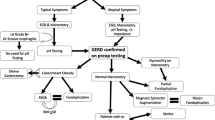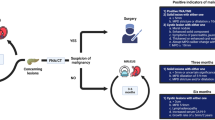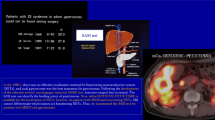Opinion statement
Patients with familial adenomatous polyposis (FAP) have a cumulative lifetime risk of over 90% for developing duodenal adenomas, which are the precursor lesions for duodenal adenocarcinoma. Consequently, these patients have a 5% to 10% lifetime risk of periampullary or duodenal adenocarcinoma, making this the leading cause of cancer death in FAP patients who have had prophylactic colectomies. The increased relative risk of duodenal carcinoma in FAP patients and the poor outcomes associated with the treatment of advanced duodenal cancer have led to the development of prevention strategies for this cancer in the setting of FAP. It is generally accepted that surveillance for duodenal adenomas and adenocarcinomas should be included in the management of patients with FAP, although there are few data from clinical trials that demonstrate the effectiveness of surveillance strategies or chemoprevention for the prevention of death from duodenal cancer. Prospective case series have shown that endoscopic surveillance with endoscopic or surgical treatment of high-risk lesions in the duodenal or periampullary region can be performed with successful removal of the at-risk lesion(s). Surveillance should begin at about 21 years of age and should be performed using both an end-viewing and a side-viewing upper endoscope. An interval of 3 to 5 years between examinations appears to be adequate if no polyposis is evident. Once polyposis develops, an interval of 1 to 3 years between screenings for mild polyposis is appropriate. Patients with denser polyposis or larger adenomas are recommended to undergo examination every 6 to 12 months because of their increased risk of developing duodenal adenocarcinoma. Nonsteroidal anti-inflammatory drug therapy with sulindac, a nonselective cyclooxygenase (COX) inhibitor, or celecoxib, a COX-2 selective inhibitor, may be of benefit after the development of duodenal polyposis by inducing the regression or stabilization of the polyposis, although there is limited evidence from randomized, controlled trials to support its routine use. Almost all cases of adenocarcinoma occur in patients with advanced polyposis (Spigelman stage IV disease), and approximately 33% of this group will go on to develop adenocarcinoma if left untreated. The most definitive procedure for reducing the risk of adenocarcinoma is surgical resection of the ampulla and/or duodenum. Pancreaticoduodenectomy or pancreas-sparing duodenectomy are appropriate surgical therapies that are believed to substantially reduce the risk of developing periampullary adenocarcinoma. However, these procedures are associated with significant morbidity and mortality, including the risk of inducing desmoid tumor formation in FAP patients.
Similar content being viewed by others
References and Recommended Reading
Funkenstein O: Uber polyposis intestinalis. Zeitschrift fur Klinische Medizinische Berlin 1904, 55:236–248.
Offerhaus GJ, Giardiello FM, Krush AJ, et al.: The risk of upper gastrointestinal cancer in familial adenomatous polyposis. Gastroenterology 1992, 102:1980–1982.
Bulow S, Alm T, Fausa O, et al.: Duodenal adenomatosis in familial adenomatous polyposis. DAF Project Group. Int J Colorectal Dis 1995, 10:43–46.
Domizio P, Talbot IC, Spigelman AD, et al.: Upper gastrointestinal pathology in familial adenomatous polyposis: results from a prospective study of 102 patients. J Clin Pathol 1990, 43:738–743.
Wallace MH, Phillips RK: Upper gastrointestinal disease in patients with familial adenomatous polyposis. Br J Surg 1998, 85:742–750.
Spigelman AD, Williams CB, Talbot IC, et al.: Upper gastrointestinal cancer in patients with familial adenomatous polyposis. Lancet 1989, 2:783–785.
Church JM, McGannon E, Hull-Boiner S, et al.: Gastroduodenal polyps in patients with familial adenomatous polyposis. Dis Colon Rectum 1992, 35:1170–1173.
Moozar KL, Madlensky L, Berk T, Gallinger S: Slow progression of periampullary neoplasia in familial adenomatous polyposis. J Gastrointest Surg 2002, 6:831–837; discussion 837.
Burke CA, Beck GJ, Church JM, van Stolk RU: The natural history of untreated duodenal and ampullary adenomas in patients with familial adenomatous polyposis followed in an endoscopic surveillance program. Gastrointest Endosc 1999, 49:358–364.
Groves CJ, Saunders BP, Spigelman AD, Phillips RK: Duodenal cancer in patients with familial adenomatous polyposis (FAP): results of a 10 year prospective study. Gut 2002, 50:636–641. Prospective cohort study that followed 114 patients with FAP and specifically observed periampullary/duodenal polyposis progression as well as incidence of carcinoma.
Bjork J, Akerbrant H, Iselius L, et al.: Periampullary adenomas and adenocarcinomas in familial adenomatous polyposis: cumulative risks and APC gene mutations. Gastroenterology 2001, 121:1127–1135.
Jagelman DG, DeCosse JJ, Bussey HJ: Upper gastrointestinal cancer in familial adenomatous polyposis. Lancet 1988, 1:1149–1151.
Heiskanen I, Kellokumpu I, Jarvinen H: Management of duodenal adenomas in 98 patients with familial adenomatous polyposis. Endoscopy 1999, 31:412–416.
Pauli RM, Pauli ME, Hall JG: Gardner syndrome and periampullary malignancy. Am J Med Genet 1980, 6:205–219.
Matsumoto T, Iida M, Nakamura S, et al.: Depressed adenoma of the duodenum in patients with familial adenomatous polyposis: endoscopic and immunohistochemical features. Cancer 1999, 86:1414–1420.
Decosse JJ, Miller HH, Lesser ML: Effect of wheat fiber and vitamins C and E on rectal polyps in patients with familial adneomatous polyposis. J Natl Cancer Inst 1989, 6:1290–1297.
Hioki K, Shivapurkar N, Oshima H, et al.: Suppression of intestinal polyp development by low-fat and highfiber diet in Apc (delta716) knockout mice. Carcinogenesis 1997, 18:1863–1865.
Oshima M, Dinchuk JE, Kargman SL, et al.: Suppression of intestinal polyposis in Apc delta716 knockout mice by inhibition of cyclooxygenase 2 (COX-2). Cell 1996, 87:803–809.
Steinbach G, Lynch PM, Phillips RK, et al.: The effect of celecoxib, a cyclooxygenase-2 inhibitor, in familial adenomatous polyposis. N Engl J Med 2000, 342:1946–1952. Randomized, controlled, double-blind study of NSAID therapy for the treatment of polyposis in FAP patients.
Giardiello FM, Offerhaus JA, Tersmette AC, et al.: Sulindac induced regression of colorectal adenomas in familial adenomatous polyposis: evaluation of predictive factors. Gut 1996, 38:578–581.
Phillips RK, Wallace MH, Lynch PM, et al.: A randomised, double blind, placebo controlled study of celecoxib, a selective cyclooxygenase 2 inhibitor, on duodenal polyposis in familial adenomatous polyposis. Gut 2002, 50:857–860. Randomized, controlled, double-blind study of NSAID therapy for the treatment of polyposis in FAP patients.
Bussey HJ, DeCosse JJ, Deschner EE, et al.: A randomized trial of ascorbic acid in polyposis coli. Cancer 1982, 50:1434–1439.
Seow-Choen F, Vijayan V, Keng V: Prospective randomized study of sulindac versus calcium and calciferol for upper gastrointestinal polyps in familial adenomatous polyposis. Br J Surg 1996, 83:1763–1766.
Thomas MG, Thomson JP, Williamson RC: Oral calcium inhibits rectal epithelial proliferation in familial adenomatous polyposis. Br J Surg 1993, 80:499–501.
Richard CS, Berk T, Bapat BV, et al.: Sulindac for periampullary polyps in FAP patients. Int J Colorectal Dis 1997, 12:14–18.
Nugent KP, Farmer KC, Spigelman AD, et al.: Randomized controlled trial of the effect of sulindac on duodenal and rectal polyposis and cell proliferation in patients with familial adenomatous polyposis. Br J Surg 1993, 80:1618–1619.
Debinski HS, Trojan J, Nugent KP, et al.: Effect of sulindac on small polyps in familial adenomatous polyposis. Lancet 1995, 345:855–856.
Vasen HF, Bulow S, Myrhoj T, et al.: Decision analysis in the management of duodenal adenomatosis in familial adenomatous polyposis. Gut 1997, 40:716–719.
Dunlop MG: Guidance on gastrointestinal surveillance for hereditary non-polyposis colorectal cancer, familial adenomatous polypolis, juvenile polyposis, and Peutz-Jeghers syndrome. Gut 2002, 51(suppl 5):V21-V27.
Burt RW: Gastric fundic gland polyps. Gastroenterology 2003, 125:1462–1469.
Bertoni G, Sassatelli R, Tansini P, et al.: Jejunal polyps in familial adenomatous polyposis assessed by push-type endoscopy. J Clin Gastroenterol 1993, 17:343–348.
Burt RW: Colon cancer screening. Gastreoenterology 2000, 11:837–853. Comprehensive review of colorectal and associated cancer screening, including rare syndromes.
Norton ID, Geller A, Petersen BT, et al.: Endoscopic surveillance and ablative therapy for periampullary adenomas. Am J Gastroenterol 2001, 96:101–106.
Alarcon FJ, Burke CA, Church JM, van Stolk RU: Familial adenomatous polyposis: efficacy of endoscopic and surgical treatment for advanced duodenal adenomas. Dis Colon Rectum 1999, 42:1533–1536.
Ghilain JM, Dive C: Endoscopic laser therapy for small villous adenomas of the duodenum. Endosocopy 1994, 26:308–310.
Ahmad NA, Kochman ML, Long WB, et al.: Efficacy, safety and clinical outcomes of endoscopic mucosal resection: as study of 101 cases. Gastrointest Endosc 2002, 55:390–396.
DiSario J, Samowitz W, Burt R, Kuwada S: Endoscopic therapy of large gastroduodenal polyps in familial adenomatous polyposis. Gastrointest Endosc 2002, 55:AB138.
Cotton PB, Lehman G, Vennes J, et al.: Endoscopic sphincterotomy commplications and their management: an attempt at consensus. Gastrointestinal Endosc 1991, 37:383–393.
Binmoeller KF, Boaventura S, Ramsperger K, Soehendra N: Endoscopic snare excision of benign adenomas fo the papilla of Vater. Gastrointest Endosc 1993, 39:127–131.
Desilets DJ, Dy RM, Ku PM, et al.: Endoscopic management of tumors of the major duodenal papilla: refined techniques to improve outcome and avoid complications. Gastrointest Endosc 2001, 54:202–208.
Park SW, Song SY, Chung JB, et al.: Endoscopic snare resection for tumors of the ampulla of Vater. Yonsei Med J 2000, 41213–41218.
Zadorova Z, Dvofak M, Hajer J: Endoscopic therapy of benign tumors of the papilla of Vater. Endoscopy 2001, 33:345–347.
Bleau BL, Gostout CJ: Endoscopic treatment of ampullary adenomas in familial adenomatous polyposis. J Clin Gastroenterol 1996, 22:237–241.
DiSario JA, Giampaolo A, Samowitz WS, Burt RW: Endoscopic management of ampulla of Vater lesions in familial adenomatous polyposis. Gut 2002, 51(suppl III):A278.
Regula J, MacRobert AJ, Gorchein A, et al.: Photosensitisation and photodynamic therapy of oesophageal, duodenal, and colorectal tumours using 5 aminolaevulinic acid induced protoporphyrin IX—a pilot study. Gut 1995, 36:67–75.
Mkvy P, Messmann H, Debinski H, et al.: Photodynamic therapy for polyps in familial adenomatous polyposis —a pilot study. Eur J Cancer 1995, 31A:1160–1165.
Penna C, Phillips RK, Tiret E, Spigelman AD: Surgical polypectomy of duodenal adenomas in familial adenomatous polyposis: experience of two European centres. Br J Surg 1993, 80:1027–1029.
Penna C, Bataille N, Balladur P, et al.: Surgical treatment of severe duodenal polyposis in familial adenomatous polyposis. Br J Surg 1998, 85:665–668.
Cameron JL, Pitt HA, Yeo CJ, et al.: One hundred and forty-five consecutive pancreaticoduodenectomies without mortality. Ann Surg 1993, 217:430–435; discussion 435–438.
Barens SA, Lillemoe KD, Kaufman HS, et al.: Pancreaticoduodenectomy for benign disease. Am J Surg 1996, 171:131–134; discussion 134–135.
Sosa JA, Bowman HM, Gordon TA, et al.: Importance of hospital volume in the overall management of pancreatic cancer. Ann Surg 1998, 228:429–438.
Ruo L, Coit DG, Brennan MF, Guillem JG: Long-term follow-up of patients with familial adenomatous polyposis undergoing pancreaticoduodenal surgery. J Gastrointest Surg 2002, 6:671–675. A retrospective cohort review of FAP patients undergoing pancreaticoduodenectomy with follow-up survival data.
Rosemurgy AS, Bloomston M, Serafini FM, et al.: Frequency with which surgeons undertake pancreaticoduodenectomy determines length of stay, hospital charges, and in-hospital mortality. J Gastrointest Surg 2001, 5:21–26.
Porter GA, Pisters PW, Mansyur C, et al.: Cost and utilization impact of a clinical pathway for patients undergoing pancreaticoduodenectomy. Ann Surg Oncol 2000, 7:484–489.
Lundell L, Hyltander A, Liedman B: Pancreas-sparing duodenectomy: technique and indications. Eur J Surg 2002, 168:74–77.
Kalady MF, Clary BM, Tyler DS, Pappas TN: Pancreaspreserving duodenectomy in the management of duodenal familial adenomatous polyposis. J Gastrointest Surg 2002, 6:82–87.
Saurin JC, Ligneau B, Ponchon T, et al.: The influence of mutation site and age on the severity of duodenal polyposis in patients with familial adenomatous polyposis. Gastrointest Endosc 2002, 55:342–347.
Author information
Authors and Affiliations
Rights and permissions
About this article
Cite this article
Johnson, J.C., DiSario, J.A. & Grady, W.M. Surveillance and treatment of periampullary and duodenal adenomas in familial adenomatous polyposis. Curr Treat Options Gastro 7, 79–89 (2004). https://doi.org/10.1007/s11938-004-0028-y
Issue Date:
DOI: https://doi.org/10.1007/s11938-004-0028-y




